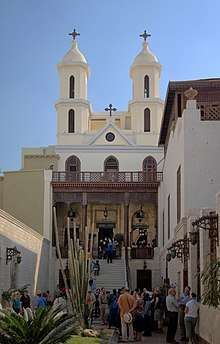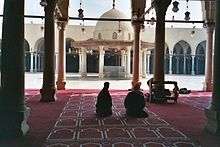Islamization of Egypt
The Islamization of Egypt occurred as a result of the Muslim conquest of Roman Egypt by the Arabs led by the prominent Muslim general Amr ibn al-Aas, the military governor of the Holy Land. The masses of locals in Egypt and the Middle East underwent a large scale gradual conversion from Christianity to Islam, accompanied by heavy taxes for those who refused to convert.[1] This is attested to by John of Nikiû, a coptic bishop who wrote about the conquest, and who was a near contemporary of the events he described. The process of Islamization was accompanied by a simultaneous wave of Arabization. These factors resulted in Islam becoming the dominant faith in Egypt between 10th and 12th century, Egyptians acculturating into an Islamic identity and then replacing Coptic and Greek, which were spoken as a result of the Greek and Roman occupation of Egypt, languages with Arabic as their sole vernacular which became the language of the nation by law.[2]

Part of a series on the |
||||||||||||||||||
|---|---|---|---|---|---|---|---|---|---|---|---|---|---|---|---|---|---|---|
| History of Egypt | ||||||||||||||||||
 | ||||||||||||||||||
|
||||||||||||||||||
|
||||||||||||||||||
|
||||||||||||||||||
|
||||||||||||||||||
|
||||||||||||||||||
|
||||||||||||||||||
|
| ||||||||||||||||||

Islamic links to Coptic Egypt predates its conquest by the Arabs. According to Muslim tradition, Mohammed married a Copt; Maria al-Qibtiyya. In 641 AD, Egypt was invaded by the Arabs who faced off with the Byzantine army. Local resistance by the Egyptians began to materialize shortly thereafter and would last until at least the ninth century.[3][4]
The Arabs imposed a special tax, known as jizya, for those who refused to convert to Islam, the Christians who acquired the protected status of dhimmis, the taxation was justified on protection grounds since local Christians who kept their religion were never drafted to serve in an army. Arab rulers generally preferred not to share the rule with Coptic Christians in their towns and established new colonies, like Fustat. Heavy taxation at times of state hardships was a reason behind Coptic Christians organizing resistance against the new rulers. This resistance mounted to armed rebellions against the Arabs in a number of instances, such as during the Bashmurian revolt in the Delta.
The Arabs in the 7th century seldom used the term Egyptian, and used instead the term qbt, which was adopted into English as Copt, to describe the locals of Egypt they kept using the term up until the Mamluk rule. Thus, Egyptians became known as Al Qibt, and the non-Chalcedonian Egyptian Church became known as the Coptic Church. The Chalcedonian Church remained known as the Melkite Church. In Coptic, which is written using a Greek alphabet, Coptic Egyptians referred to themselves as ⲛⲓⲣⲉⲙⲛ̀ⲭⲏⲙⲓ (/ni-rem-en-kēmi/ "Egyptians"). Religious life remained largely undisturbed following the establishment of Arab rule, as evidence by the rich output of Coptic Orthodox Christian arts in monastic centers in Old Cairo (Fustat) and throughout Egypt. Conditions, however, worsened shortly after that, and in the eighth and ninth centuries when Muslim rulers banned the use of human forms in art (taking advantage of an iconoclastic conflict in the European ruled Byzantium) and consequently destroyed many Coptic christian paintings mainly of Jesus and frescoes in churches.[5]
The Fatimid period in Egypt was a time of relative tolerance. The Fatimid rulers employed Copts in the government and participated in Coptic and local Egyptian feasts. Major renovation and reconstruction of churches and monasteries were also undertaken. Coptic arts flourished, reaching new heights in Middle and Upper Egypt.[6]
See also
- Islamization
- Spread of Islam
- Muslim conquests
References
- Conversion, Exemption, and Manipulation: Social Benefits and Conversion to Islam in Late Antiquity and the Middle Ages: Forcing taxes on those who refuse to convert (PDF),
ʿUmar is depicted as having ordered that "the poll-tax should be taken from all men who would not become Muslims"
- Clive Holes, Modern Arabic: structures, functions, and varieties, Georgetown University Press, 2004, ISBN 978-1-58901-022-2, M1 Google Print, p. 29.
- Mawaiz wa al-'i'tibar bi dhikr al-khitat wa al-'athar (2 vols., Bulaq, 1854), by Al-Maqrizi
- Chronicles, by John of Nikiû
- Kamil, p. 41
- Kamil, op cit.
Sources
- Betts, Robert B. (1978). Christians in the Arab East: A Political Study (2nd rev. ed.). Athens: Lycabettus Press.CS1 maint: ref=harv (link)
- Charles, Robert H. (2007) [1916]. The Chronicle of John, Bishop of Nikiu: Translated from Zotenberg's Ethiopic Text. Merchantville, NJ: Evolution Publishing.CS1 maint: ref=harv (link)
- Kamil, Jill. Coptic Egypt: History and a Guide. Revised Ed. American University in Cairo Press, 1990.
- Meyendorff, John (1989). Imperial unity and Christian divisions: The Church 450-680 A.D. The Church in history. 2. Crestwood, NY: St. Vladimir's Seminary Press.CS1 maint: ref=harv (link)
- Ostrogorsky, George (1956). History of the Byzantine State. Oxford: Basil Blackwell.CS1 maint: ref=harv (link)